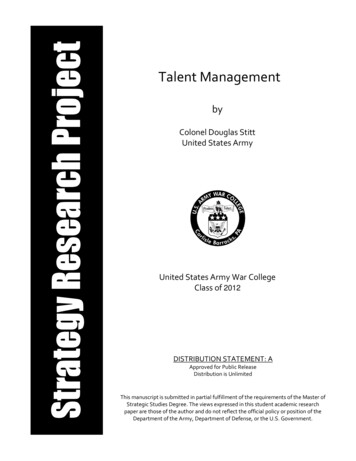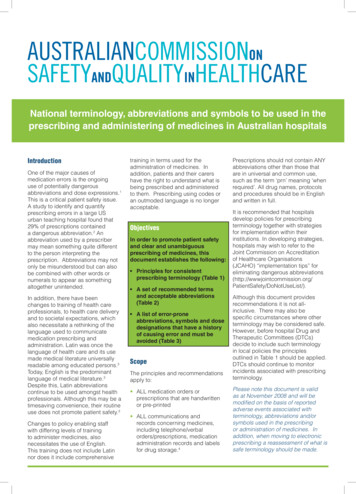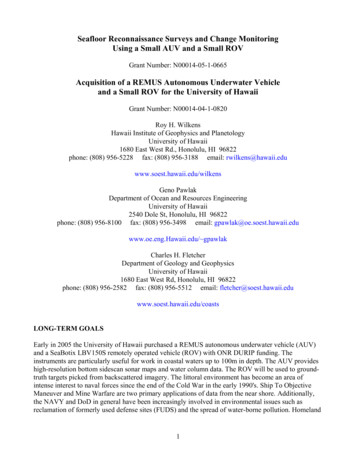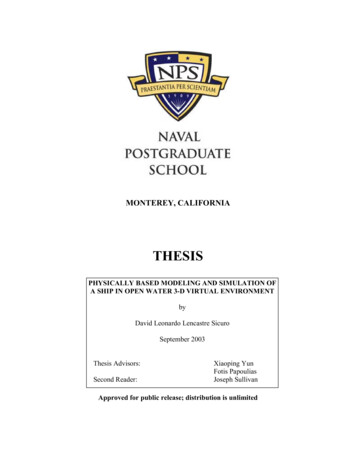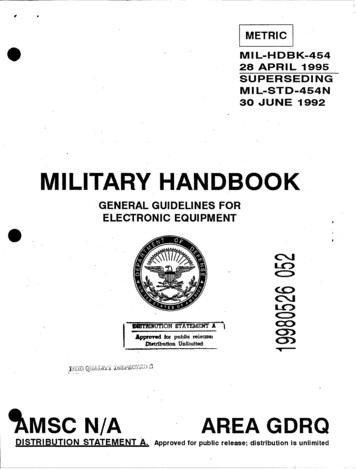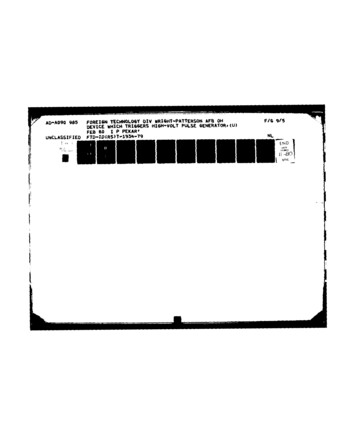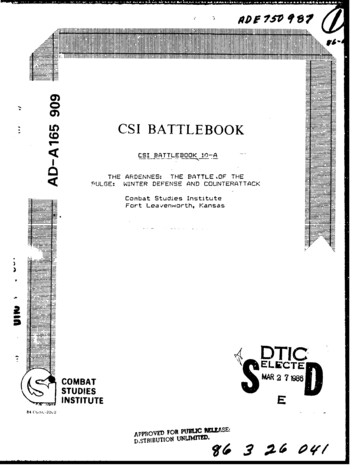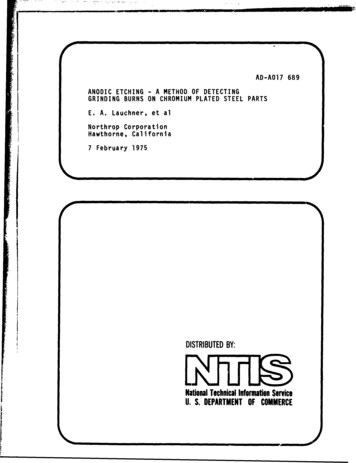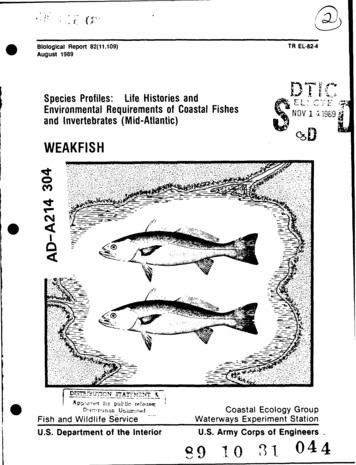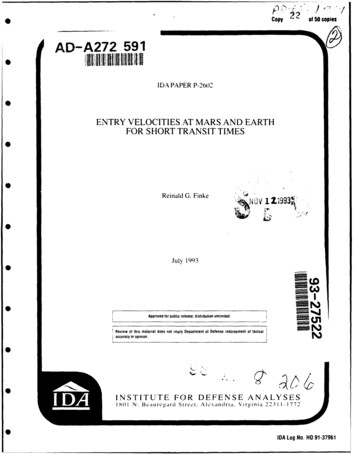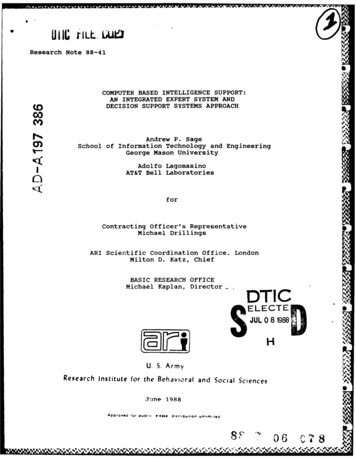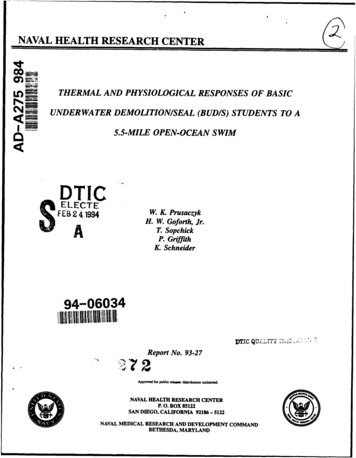
Transcription
NAVAL HEALTH RESEARCH CENTER,q.Jn-N Q'iTHERMAL AND PHYSIOLOGICAL RESPONSES OF BASICUNDERWATER DEMOLITION/SEAL (BUDIS) STUDENTS TO A5.5-MILE OPEN-OCEAN SWIMDTICELECTEFEB24 1994W. K. PrusaczykH. W. Goforth, Jr.AT. SopchickP. GriffithK. Schneider94-06034PTILC QUA Report No. 93-27Appraved for publik relmn: dtnribution unlimited.NAVAL HEALTH RESEARCH CENTERP.O. BOX 85122SAN DIEGO, CALIFORNIA 92186 - 5122NAVAL MEDICAL RESEARCH AND DEVELOPMENT COMMANDBETHESDA, MARYLANDL7
Thermal & Physiological Responses Of Basic UnderwaterDemolition/SEAL (BUD/S) Students to a 5.5-mileOpen-ocean SwimNTISD iCW.K. Prusaczyk, Ph.D.H.W. Goforth, Jr., Ph.D.T. Sopchick, B.S.P. Griffith, M .S.K. Schneider, B.S.U3.C .,,-l,'a.3F- cBy.Distribution IAvzilab:i iy CodesNaval Health Research CenterP.O. Box 85122San Diego, CA 92186-5122DistAvI pcialc:OrA1-)Report 93-27, supported by the Naval Medical Research and Development Command, Departmentof the Navy under work unit 62233N MM33P30.002-6005. The views expressed in this articleare those of the author(s) and do not reflect the official policy or position of the Department ofthe Navy, the Department of Defense, or the U.S. Government. Approved for public release;distribution is unlimited.
SUMMARYProblem.Cold stress can compromise Naval Special Warfare (NSW) training and operations. Theresulting cold strain and performance degradation can jeopardize mission success as well asoperator safety.The selection and use of thermal protection equipment has been based onoperational experience and passed on as "lessons learned." There is, however, a relative lack ofobjective data on the adequacy of thermal protection equipment in NSW scenarios.Obiective.This study was performed to evaluate physiological and thermoregulatory responses ofBasic Underwater Demolition/SEAL (BUD/S) students to a 5.5 mile open-ocean swim. Studieswere conducted twice when the wiaer temperature was similar, but different thermal protectionensembles were worn. Changes in core body (rectal) temperature were used as indicators of theadequacy of the thermal protection equipment.Approach.Anthropometric data (height, weight, and skinfold thicknesses for calculating percent bodyfat) were obtained. Prior to the swim, body weights were taken and core body temperatures weremeasured using flexible thermocouples inserted into the rectum 15 cm (6 in) beyond the analsphincter. Subjects then donned the thermal protection ensemble and performed the swim. Uponcompletion of the swim, subjects had body weight and core body temperature remeasured.Results.Thirty-six Second Phase (Diving) students participated during a December 1991 (DEC)swim (water temperature 13.9 C [57 F]). They averaged 6.6% body fat and dressed in wholebody wet suits (9 mm [3/8 in]) with booties, hoods, masks, and fins. Mean swim time was 240.7t 23.6 minutes. The time delay between exiting the water and having core body temperaturemeasured was 13.4 t 2.2 minutes. Swimmers showed a mean t SD core temperature drop of0.6 t 0.120 C (1.1 t 0.2 0 F) and drop rate of -0.08 t 0.09*C-hr"' (-0.14 t 0.17 F-hr'). The meanweight loss (dehydration due to diuresis) was 2.3 t 0.1 kg (5.0 t 0.2 ib), or 3% of body weight.2
Swim time was correlated with temperature drop (r -0.47; p 0.01), but not weight loss orbody fat.Twenty-four different students participated in an April 1992 (APR) swim (watertemperature 17.2 C [63 F]).The mean time between water exit and core temperaturemeasurement was 19.6 13.9 minutes. They had a mean of 6.7 0.2% body fat and dressedin wet suit tops (9 mm[3/8in]) with booties, hoods, masks, and fins. Mean swim time was 232.8 12.6 minutes. These students had a mean core temperature change of -1.41 0.78 0 C (-2.5 1.4 F) and a drop rate of -0.36 0.09 C-hr' (-0.65 0.17 F-hr"). Mean weight loss was 1.5 1.0 kg (3.3 2.2 Ib), or 2% of body weight. There were no significant correlations among themeasured variables.Conclusions.Despite the warmer water temperatures in APR, students had greater core temperaturedrops and greater drop rates than in DEC. Additionally, three students had mildly hypothermictemperatures (s 35 C [95 F]) in APR, compared to one in DEC. Swim speed (and exposuretimes) were the same for the swims, suggesting that metabolic heat production was similar.Similarity of body fat suggests that subcutaneous insulation was the same. The difference in coretemperature response is likely due to the thermal protection on the swimmers' legs; wet suit topin APR compared to full body wet suit in DEC. In DEC, the active musculature of the legs wascovered, effectively reducing the body-to-water thermal gradient resulting in greater body heatconservation. These data suggest that the practice of selecting thermal protection equipmentbased on water temperature may not be the most appropriate for ensuring participant safety.3
INTRODUCTIONThermal stress can have a substantial negative impact on the performance of NavalSpecial Warfare (NSW) personnel during training and missions. This effect is especially evidentduring prolonged operations in cold water. Cold water is a particularly inhospitable environment.Heat conduction of water is 25 times that of air (Bullard & Rapp, 1970) causing loss of bodyheat two to four times faster in water than in air at the same temperature (Rennie, Covino,Howell, Song, Kang, & Hong, 1962). The rate of heat production by a swimmer and of bodyheat loss to the water are critical factors in core body temperature homeostasis (Webb, 1979).In cool and cold waters, the metabolic heat produced by swimming can be inadequate tocounteract the large thermal drain imposed by the water. Although heat production is increasedduring exercise, heat loss is also increased.Reducing body heat loss to the water becomescritical for the prevention of hypothermia when metabolic heat production is less than heat loss.In addition to compensatory physiological responses (e.g., cutaneous vasoconstriction),during severe or prolonged cold water immersion, adequate thermal protection must be achievedthrough engineering solutions (Bachrach, 1981, 1985).During NSW training exercises andoperations, wet suits and dry suits are frequently employed during cool/cold water exposures.During prolonged ( 3 hrs) immersion, especially in cool or cold water ( 15.6 C [60 F]), wetsuits may be insufficient protection against hypothermia.The design characteristics and effectiveness of many passive thermal protection systemshave been studied in detail (Brewster & Sterba, 1988; Nuckols, 1978; Virr, 1984), includingattempts to replicate the field conditions in the laboratory (e.g., Doubt, Weinberg, Hesslink, &Ahlers, 1989). However, the performance of thermal protection equipment in the operationalenvironment can differ substantially from immersion studies conducted in the laboratory(Steinman, Hayward, Nemiroff, & Kubilis, 1987).The ultimate purpose of any thermalprotection system is to maintain adequate physiological function and performance of the diver.During military operations, there is the additional goal of maintaining mission capability.Participants at the 1991 NSW Thermal Protection Workshop (Doubt & Curley, 1992) concludedthat there was a need for a comprehensive evaluation of the thermal protection equipment usedby NSW operators in operationally relevant scenarios.4
Students in Basic Underwater Demolition/SEAL (BUD/S) training at the Naval SpecialWarfare Center, Coronado, California, are required to perform a 5.5 mile open-ocean surfaceswim during Second Phase (Diving). Over the course of a year, water temperatures encounteredduring the swim can vary widely (100 to 25 0 C [500 to 770 F]). Students are exposed to thesewaters for periods of 3 to 6 hours, depending on their swim speed. Naval Special WarfareCenter Instruction 1500.3B (Appendix A) mandates the use of thermal protection ensembles forswims over two miles, with the degree of protection dependent on the water temperature. Whenwater temperatures are 15.6 C (60*F) or below, students must wear a full-body wet suit (top andbottom) with hood, booties, and gloves. Above 15.6 C (60'F), students wear only a wet suit top(shortie) with hood and booties.Despite the mandated use of the thermal protection ensembles, cases of hypothermia (corebody temperature 35 C [95 0 F]) have occurred during the swims. Cases of mild hypothermiaare typically identified by instructors monitoring the swimmers' behavior/performance from safetyboats during the swim or on shore immediately thereafter. Once identified, the swimmer istreated in the clinic at the Naval Special Warfare Center by supervised active rewarming usinghead-out, limb-out warm-water immersion. Despite the ready availability of medical treatmentfacilities and constant supervision of the instructors, the actual number of swimmers that becomemildly hypothermic during these swims is unknown since only those displaying overt impairmentare identified.As part of a larger program to evaluate the efficacy of thermal protection in current NSWoperating environments (NSW Biomedical Task 2-90), Naval Health Research Center(NAVHLTHRSCHCEN) personnel monitored select thermal and metabolic responses of BUD/Sstudents during two 5.5 mile swims. This study was conducted in conjunction with normaltraining at BUD/S, and constituted only limited additional risk to the participants.METHODSSubjectsA total of 60 BUD/S students volunteered to participate during two separate 5.5 mileopen-ocean swims: 36 students in a December 1991 swim and 24 in an April 1992 swim. Thephysical characteristics of these students are summarized in Table 1.5
Table 1. Physical characteristicst of students participating in two separate 5.5 mile open-oceanswims.Swim Daten[yr][Cm]body .2)All values are means (SD).ProceduresApproximately seven days prior to each swim, students were briefed on the purposes ofthe study and on the equipment and procedures to be employed. Students electing to participatesigned an informed consent agreement approved by the NAVHLTHRSCHCEN's Committee forthe Protection of Human Subjects.Five days prior to the swim, each student's height, weight, and percent body fat wasdetermined. Body fat was estimated from body density (Siri, 1956) and 7-site skinfold thickness(Jackson & Pollock, 1978). Each student recorded all foods and beverages consumed during thethree days immediately preceding the swim. The diet records included detailed instructions forthe proper recording of food/beverage type and portion size. A "baseline" blood sample wasdrawn from an antecubital vein (with tourniquet) approximately 24 hours prior to the estimatedtime of completion of the swim. Blood was collected in 15 mL EDTA test tubes, placed on ice,then refrigerated at 4"C for subsequent determination of plasma glucose concentration (YSIModel 1500 SPORT L-lactate analyzer, Yellow Springs Instrument Corp., Yellow Springs, OH).Subjects were at least 3.5 hours postprandial (after eating) at the time of the blood draw.On the day of the swim, body weights were measured with students dressed in UDTs(shorts weighing approximately 0.5 kg [1.1 lb]) prior to donning the wet suits. Next, eachstudent inserted a flexible, disposable rectal thermistor (Sher-I-Temp LTU/UC, SheridanCatheter Corp., Argyle, NY) into the rectum approximately 15 cm (6 in) beyond the analsphincter. To facilitate insertion to the proper depth, all probes had a small piece of adhesive6
tape at the appropriate depth. The probe leads were then connected to a calibrated, batteryoperated datalogger (SQ32-10YS/1hr Squirrel, Science Electronics, Dayton, OH) for display.When the temperature reading stabilized, core body temperatures were recorded. Students thenreturned to the dressing room, removed the probe, donned their thermal protection ensembles,and reported to the beach for the swim.Each swimmer was paired with a partner of similar ability based on previous swim times.In December, students wore a full-body wet suit (9.5 mm [3/8 in] thickness) with hood, booties,fins, and mask. In April, students wore a wet suit top (9.5 mm[3/.in] thickness) covering thetorso and shoulders, with hood, booties, fins, and mask.Students mustered in formation on the beach, then swam in pairs to a buoy outside thesurf zone, approximately 100 m from the beach. The swimmers assembled at the buoy for thestart of the massed swim. At the midpoint of the swim (2.75 miles), students were required toingest approximately 1 L of a glucose polymer/electrolyte beverage (Exceed, Ross Laboratories,Columbus, OH) containing 50 g of carbohydrates. During the swim, water temperature, wind,and surf conditions were monitored and recorded. Time of water entry, buoy-to-buoy swim time,water exit, and time from water exit until measurement of core body temperature were alsorecorded.Immediately following the swim, in accordance with the training schedule, studentsreturned to the beach and performed 40 pushups. Students then returned to the building wherethe preswim measurements were made, a distance of approximately 100 m (70 m over sand, 30m over pavement). The students rapidly removed the thermal protection ensembles, toweled dry,inserted a rectal probe, and reported for recording body weight and core temperature, using thesame techniques as before the swim. Each student then had a blood sample drawn from anantecubital vein (with tourniquet) into a 15 mL EDTA tube for subsequent determination ofplasma glucose concentration.AnalysesDiet records were analyzed using Nutritionist III software (Analytic Software, Salem, OR).Descriptive and inferential statistics tests were performed using SigmaStat statistical software(Jandel Scientific, San Rafael, CA). Group comparisons were performed using the Students' ttest and correlations calculated using the Pearson product-moment correlation coefficient. A7
significance level of 0.05 was selected to evaluate the differences between means. All data arereported as mean (t SD).RESULTSFood/Fluid IntakeThe two groups of students were not significantly different in any of the physicalcharacteristics measured (Table 1). Table 2 summarizes the food and fluid intake reported bythe students prior to the swims. Macronutrient constituents are reported both in grams and asa percent of total caloric intake.Table 2. Average daily food and fluid intake of BUD/S students over three days prior to a 5.5mile open-ocean fFatCHOCHO[%keels]191[%keel )5.3(1.6)t All values are mean (SD) daily average over three days.December SwimThe water temperature was 13.0 C (57TF) for the December 1991 swim. The mean swimtime was 240.7 ( 23.6) minutes, for an average swim speed of 1.14 ( 0.13) knots. During theswim, the mean core body temperature dropped 0.6 C ( 0.1 C) [1.1 F ( 0.2 F)], with one student(2.7% of December swimmers) exhibiting a hypothermic temperature (34.9 C [94.9 F]) after theswim. Table 3 summarizes the thermal responses of the students during this swim. Students' bodyweight decreased an average of 2.3 kg ( 0.1) [5.1 0.2 lb] during the swim, or approximately 3%of preswim body weight. Body water lost during the swim probably resulted primarily from coldand immersion-induced diuresis. Swim time was significantly correlated (r 0.47; p 0.01) withdecrease in core body temperature, but not with body weight loss or % body fat.8Mean plasma
glucose concentration after the swim (88.5 [ 12.61 mgdL") was nonsignificantly higher thanbaseline (85.6 [ 17.3] mgdL-').April SwimDuring the April 1992 swim, the water temperature was 16.7 C (62 F). The mean swim timewas 232.8 ( 12.6) minutes, for an average speed of 1.20 ( 0.07) knots.Mean core bodytemperature decreased 1.40 C ( 0.80 C) [1.8 0 F 0.2 F] following the swim. Three students (12.5%of April swimmers) exhibited hypothermic core body temperatures at the time of postswimtemperature measurement.The thermal responses of swimmers during the April swim aresummarized in Table 3. Weight loss during the swim averaged 1.5 ( 0.5) kg [3.2 1.0 lb], orapproximately 2% of preswim body weight.None of these variables were significantlyintercorrelated. There was a nonsignificant decrease in plasma glucose concentration from a baselinevalue of 89.2 ( 7.5) mgdL"' to 77.0 ( 10.5) mgdL-' following the swim.Table 3. Thermal responses of BUD/S students during two 5.5 mile open-ocean swims.Prewim Core Temperature(F)DatehighlowDEC100.199.2IPosumwim Core TemperatureF)Core Temperature Drop(Inmean(SD)highlowmanI e Drop Rate(*Fif' Swim .1(1.5) on of December and April SwimsThe students participating in the two swims did not differ significantly in physicalcharacteristics (Table 1).Mean swim time in December (240.7 23.6 minutes) was notsignificantly different from the April swim (232.8 12.6 minutes). The time delay betweenexiting the water and having core body temperature measured was not significantly differentbetween the December (13.4 2.2 minutes) and April (19.6 13.9 minutes) swims. Decemberswimmers had a significantly (p :s 0.001) greater body weight loss than April swimmers, and9
consequently had a significantly (p !s 0.001) greater degree of dehydration following the swim.Students in the April swim had a significantly (p s 0.001) greater overall core body temperaturedrop and drop rate than did the students in the December swim (Table 3). The change in bloodglucose during the swim was significantly (p s 0.001) different in December (small rise) thanin April (modest decline). Although the difference in blood glucose change was statisticallysignificant, all values were within the physiologically normal range.DISCUSSIONAfter completing a long cold water immersion, core body temperature typically showsan "afterdrop" (Savard, Cooper, Veale, & Malkinson, 1985; Giesbrecht & Bristow, 1992) oradditional core cooling beyond that occurring during immersion. Therefore, it is possible thatthe core body temperature measured following these swims is lower than the actual temperatureat the time the student exited the water. Nevertheless, the temperatures accurately reflect thethermal status of the swimmer shortly after water exit. During NSW operations, many missionsconsist of a wet insertion phase followed by a terrestrial action phase. In such scenarios, theNSW operator would most likely experience the lowest core body temperature in the land phaseduring afterdrop. The potential negative effects of an afterdrop in core temperature below 35 Care not known, but would depend on several factors including, but not limited to, the coretemperature on water exit, the degree of afterdrop, air temperature, thermal protection equipmentworn, and level of physical activity.The thermal stress experienced by swimmers was greater during the April swim thanduring the December swim despite the higher water temperature. In April, students had a loweraverage core body temperature after the swim, a greater average core temperature drop, and amore rapid core temperature drop rate than for students in the December swim. In addition, ahigher percentage of swimmers exhibited mildly hypothermic core temperatures in April than inDecember. The differences are most likely due to the thermal protection ensemble worn. Duringsurface swimming at BUD/S, the legs are the most active large muscle mass, and thus are themajor source of metabolic heat production and of conductive and convective heat loss (Toner,Sawka, & Pandolf, 1984). Although body fat can provide effective thermal insulation (Costill,Cahill, & Eddy, 1967; Toner, Sawka, Foley, & Pandolf, 1986), additional insulation is needed10
to maintain core body temperature during immersion in very cold water or prolonged immersionin cool water. The similarities between the two groups in body fat, hLight and weight, initialcore temperatures, and swim times (equalizing cutaneous/subcutaneous [skin and fat], exposuretime, and metabolic heat production) suggest that the differences in temperature drop isattributable to the rate of heat loss. The insulation provided by working muscles is decreasedduring exercise as blood flow to the skin and muscles is increased, promoting core heat loss(Toner & McArdle, 1988).Additionally, during swimming, convective heat loss to theenvironment is increased by the water passing over the skin at a rate proportional to swim speed(Nadel, Holmer, Bergh, Astrand, & Stolwijk, 1974; Witherspoon, Goldman, & Breckenridge,1970). In December, swimmers wearing full-body wet suits likely benefitted from increasedlower-body insulation. The greater insulation reduced the thermal gradient between the skinoverlaying the exercising leg muscles and the water. The increased insulation reduced the heatflow from core body to water, despite the fact that the swim was performed in colder water.The configuration of thermal protection equipment (e.g., insulative properties of thematerials and body areas protected) and its application (e.g., tight fit or loose fit) play major rolesin maintaining core body temperature during immersion (Steinman, et al., 1987; Wolff, Coleshaw,Newstead, & Keatinge, 1985).Studies of regional thermal protection during cold waterimmersion (e.g., Tipton & Goldman, 1987) suggest that thermal strain during the initial phasesof immersion is greater when the limbs are exposed and the torso protected, than when the limbsare protected and the torso exposed. During head-out immersion at rest, heat loss from the limbsand the torso are approximately equal. However, during exercise while immersed, heat loss fromthe limbs increases more than heat loss from the torso (Ferretti, Veicsteinas, & Rennie, 1989).During surface swimming, a wet suit similar to the one worn during the 5.5 mile swims has aninsulative value of 0.77 clo (Bradner, 1985). The December swimmers had this insulation evenlydistributed over the trunk and the exercising limbs; and while the April swimmers had the sametrunk insulation, wet suit insulation was absent over the working muscles of the legs. Althoughthe water was colder during the December swim, the increased insulation over the limbs reducedheat flow from the core to the skin and subsequently to the water. Thus, the additional protectionmade the ensemble worn more effective in maintaining core body temperature of the swimmers.The incidence of hypothermia in both swims suggests that although the thermal protection used11
during the December swim was more effective, the duration of the swims (approximately 4 hourseach) may have been a contributing factor to the cases of hypothermia. It has been noted thatalthough thermal protection systems that provide sufficient protection over short term exposures( 2 h), they may not be adequate for long.-r-14- ration exposures in preventing "silent" (orprogressive) hypothermia (Hayward & Keatinge, 1979).CONCLUSIONSThe thermal protection mandated for use during the colder water ( 15.6'C [60'F])December swim provided substantially greater thermal protection than the ensemble mandatedfor the warmer (water temperature 15.6"C [60*F]) April swim. Further study under controlledconditions is needed to fully evaluate the efficacy of standard NSW thermal protection ensemblesin reducing the probability of hypothermia during ocean swimming and in determining theperformance capabilities of NSW personnel after such exposures. The use of task-orientedperformance tests following the swims would provide more information on an operator's "missioncapability" following a wet phase of a mission.12
REFERENCESBachrach, A. J. (1981). Cold stress and diving (Technical Report No. 81-79). Bethesda, MD:Naval Medical Research Institute.Bachrach, A. J. (1985). Cold stress and the scientific diver (Technical Report No. 85-53).Bethesda, MD: Naval Medical Research Institute.Brewster, D. F. & Sterba, J. A. (1988). Market survey of commercially available dry suits(Technical Report No. 3-88). Panama City, FL: Navy Experimental Diving Unit.Bradner, H. (1985). Guidelinesfor predictingheat loss of SEAL team members in SDV and freeswimming operations (Report No. GP-R-313031). General Physics Corporation, San Diego,CA.Bullard, R. W. & Rapp, G. M. (1970).Aerospace Medicine, 41:1269-1277.Problems of body heat loss in water immersion.Costill, D. L., Cahill, P. J., & Eddy, D. (1967). Metabolic responses to submaximal exercise inthree water temperatures. Journalof Applied Physiology, 22:628-632.Doubt, T. J., Weinberg, R. P., Hesslink, R. L., Ahlers, S. T. (1989). Effects of serial wet-dry-wetcold exposure: Thermal balance, physical activity, and cognitive performance (TechnicalReport No. 89-35). Bethesda, MD: Naval Medical Research Institute.Doubt, T. J., & Curley, M. D. (1992). Proceedings of the 1991 NSW Thermal Workshop(Technical Report No. 92-84). Bethesda, MD: Naval Medical Research Institute.Ferretti, G., Veicsteinas, A. & Rennie, D. W. (1989). Conductive and connective heat flowsof exercising humans in cold water. Journalof Applied Physiology, 67(6):2473-2480.Giesbrecht, G. G. & Bristow, G. K. (1992). A second postcooling afierdrop: More evidence fora convective mechanism. Journalof Applied Physiology, 73:1253-1258.Hayward, M. G. & Keatinge, W. R. (1979). Progressive symptomless hypothermia in water:possible cause of diving accidents. British Medical Journal, 6172:1182.Jackson, A.S. & Pollock, M. L. (1978). Generalized equations for predicting body density ofmen. British Journal of Nutrition, 40:497-504.Nadel, E. R., Holmer, I., Bergh, U., Astrand, P. 0., & Stolwijk, J. A. J. (1974).exchanges of swimming men. Journalof Applied Physiology, 36:465-471.13Energy
Nuckols, M. L. (1978). Thermal considerations in the design of diver suits (Technical ManualNo. 218-78) Panama City, FL: Naval Coastal Systems Laboratory.Rennie, D. W., Covino, B. G., Howell, B. J., Song, S. H., Kang, B. S., & Hong, S. K. (1962).Physical insulation of Korean diving women. Journalof Applied Physiology, 17:961-966.Savard, G. K., Cooper, K. E., Veale, W. L., & Malkinson, T. J. (1985). Peripheral blood flowduring rewarming from mild hypothermia in humans. Journalof Applied Physiology,58:4-13.Sawka, M. N., Gonzalez, R. R., Drolet, L. L. & Pandolf, K. B. (1984). Heat exchange duringupper-and lower-body exercise. Journal of Applied Physiology, 57(4):1050-1054.Sint, W. E. (1956). Body composition from fluid spaces and density: Analysis of methods(Report No. UCRL-3349). Bericeley, CA: Donner Laboratory of Biophysica and MedicalPhysics, University of California.Steinman, A. M., Hayward, J. S., Nemiroff, M. J. & Kubilis, P. S. (1987). Immersionhypothermia: Comparative protection of anti-exposure garments in calm versus rough seas.Aviation Space and Environmental Medicine, 58:550-558."Tipton,M. J. & Goldman, F. St. C. (1987). The influence of regional insulation on the initialresponses to cold immersion. Aviation Space and EnvironmentalMedicine, 58:1192-1196.Toner, M. M., Sawka, M. N. & Pandolf, K. B. (1984). Thermal responses during arm and legand combined arm-leg exercise in water. Journal of Applied Physiology, 56:1355-1360.Toner, M. M., Sawka, M. N., Holden, W. L. & Pandolf, K. B. (1985). Comparison of thermalresponses between rest and leg exercise in water. JournalofApplied Physiology, 59:248-253.Toner, M. M., Sawka, M. N., Foley, M. E. & Pandolf, K. B. (1986). Effects of body mass andmorphology on thermal responses in water. Journalof Applied Physiology, 60:521-525.Toner, M. M. & McArdle, W. D. (1988). Physiological adjustments of man to the cold. In K.B. Pandolf, M. N. Sawka, & R. R. Gonzalez (Eds.), Human performance physiology andenvironmentalmedicine at terrestrialextremes (pp. 3 6 1-3 9 9 ). Indianapolis: Benchmark Press.Virr, L. E. (1984). Thermal protection equipment: Design and operational considerations.Proceedingsof the InternationalConference on Medical and TechnologicalProblemsofDivingRelated UnderwaterActivities in Arctic Conditions, 10(2):23-32.Webb, P. (1979). Body heat loss in diving (Contract Report No. N00014-72-C-0057). WebbAssociates, Inc., Yellow Springs, OH: Office of Naval Research.14
Witherspoon, J. M., Goldman, R. F. & Breckenridge, J. R. (1971). Heat transfer coefficients ofhumans in cold water. Journal of Physiology, 63:459-462.Wolff, A. H., Coleshaw, S. K. Newstead, C. G., Keatinge, W. R. (1985). Heat exchanges in wetsuits. Journal of Applied Physiology, 58:770-777.15
APPENDIX AWATER TEMPERATURE REGULATIONS FOR IMMERSIONAND WET SUIT PROTECTION FOR BUD/S16
1500.BNAVSPECWARCENINSTWATER TEMPERATUREREGULATIONSFOR IMMERSIONAND WETSUIT PROTECTIONTable 1.Water Immersion Time LimitsENERGY LEVEL CATEGORY/EVOLUTIONSWATER IMMERSIONLIMITS (minutes)1 FTime 601060-65 651520 602060-6525 6530HIGHLY ACTIVE (high-energy tasks involving 6040wet/dry periods,60-6550 6560STATIC(immobile,or restrictedSURF INGMODERATE (unrestricted movement)Examples: WATER PT,DOWNPROOFINGkapoks,(TREADWATER)boat crewing)Examples: LYON'S LOPE, RUN/SWIM/RUN,Table 2.MAD TANCE (Miles)WATER TEMP ('F)2 64NO WETSUIT63-64HOOD 63WETSUIT TOP AND HOODa 60WETSUIT TOP AND HOOD 60FULL WETSUIT AND HOOD 217PROTECTION REQUIRED(SKIN)
IREPORT DOCUMENTATION PAGEI' p'"EA No. 0704-01Pubkc recorting bur e fortiu cowmon atinformaon is etamaled IDeverag I hour per response. inckwig Vie wnie tar revmsng innummorm.menexieflng d
N Q' i UNDERWATER DEMOLITION/SEAL (BUDIS) STUDENTS TO A 5.5-MILE OPEN-OCEAN SWIM DTIC ELECTE FEB24 1994 W. K. Prusaczyk A H. W. Goforth, Jr. T. Sopchick P. Griffith K. Schneider 94-06034 PTILC QUA L7 Report No. 93-27 Appraved for publik relmn: dtnribution unlimited. NAVAL HEALTH RESEARCH CENTER P. O. BOX 85122 SAN DIEGO, CALIFORNIA 92186 -5122
